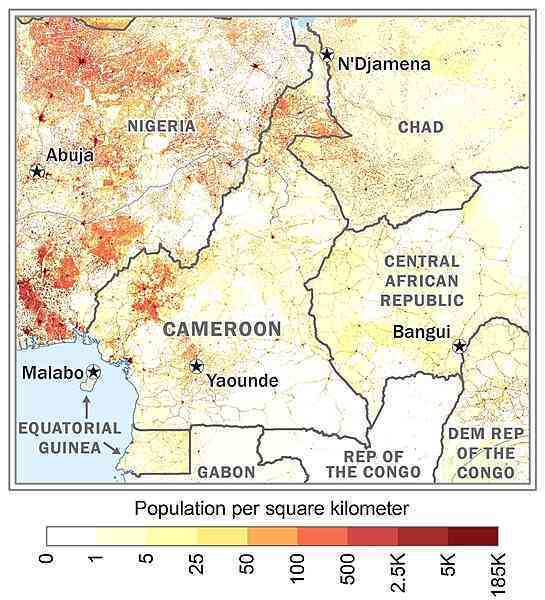
Central Africa, bordering the Bight of Biafra, between Equatorial Guinea and Nigeria
6 00 N, 12 00 E
Africa
total: 475,440 sq km
land: 472,710 sq km
water: 2,730 sq km
slightly larger than California; about four times the size of Pennsylvania
total: 5,018 km
border countries (6): Central African Republic 901 km; Chad 1,116 km; Republic of the Congo 494 km; Equatorial Guinea 183 km; Gabon 349 km; Nigeria 1975 km
402 km
territorial sea: 12 nm
contiguous zone: 24 nm
varies with terrain, from tropical along coast to semiarid and hot in north
diverse, with coastal plain in southwest, dissected plateau in center, mountains in west, plains in north
highest point: Fako on Mont Cameroun 4,045 m
lowest point: Atlantic Ocean 0 m
mean elevation: 667 m
petroleum, bauxite, iron ore, timber, hydropower
agricultural land: 20.6% (2018 est.)
arable land: 13.1% (2018 est.)
permanent crops: 3.3% (2018 est.)
permanent pasture: 4.2% (2018 est.)
forest: 41.7% (2018 est.)
other: 37.7% (2018 est.)
290 sq km (2012)
fresh water lake(s): Lake Chad (endorheic lake shared with Niger, Nigeria, and Chad) - 10,360-25,900 sq km
note - area varies by season and year to year
Atlantic Ocean drainage: Congo (3,730,881 sq km), Niger (2,261,741 sq km)
Internal (endorheic basin) drainage: Lake Chad (2,497,738 sq km)
Lake Chad Basin
population concentrated in the west and north, with the interior of the country sparsely populated as shown in this 
volcanic activity with periodic releases of poisonous gases from Lake Nyos and Lake Monoun volcanoes
volcanism: Mt. Cameroon (4,095 m), which last erupted in 2000, is the most frequently active volcano in West Africa; lakes in Oku volcanic field have released fatal levels of gas on occasion, killing some 1,700 people in 1986
sometimes referred to as the hinge of Africa because of its central location on the continent and its position at the west-south juncture of the Gulf of Guinea; throughout the country there are areas of thermal springs and indications of current or prior volcanic activity; Mount Cameroon, the highest mountain in Sub-Saharan west Africa, is an active volcano
NOTE: The information regarding Cameroon on this page is re-published from the 2024 World Fact Book of the United States Central Intelligence Agency and other sources. No claims are made regarding the accuracy of Cameroon 2024 information contained here. All suggestions for corrections of any errors about Cameroon 2024 should be addressed to the CIA or the source cited on each page.
This page was last modified 04 May 24, Copyright © 2024 ITA all rights reserved.